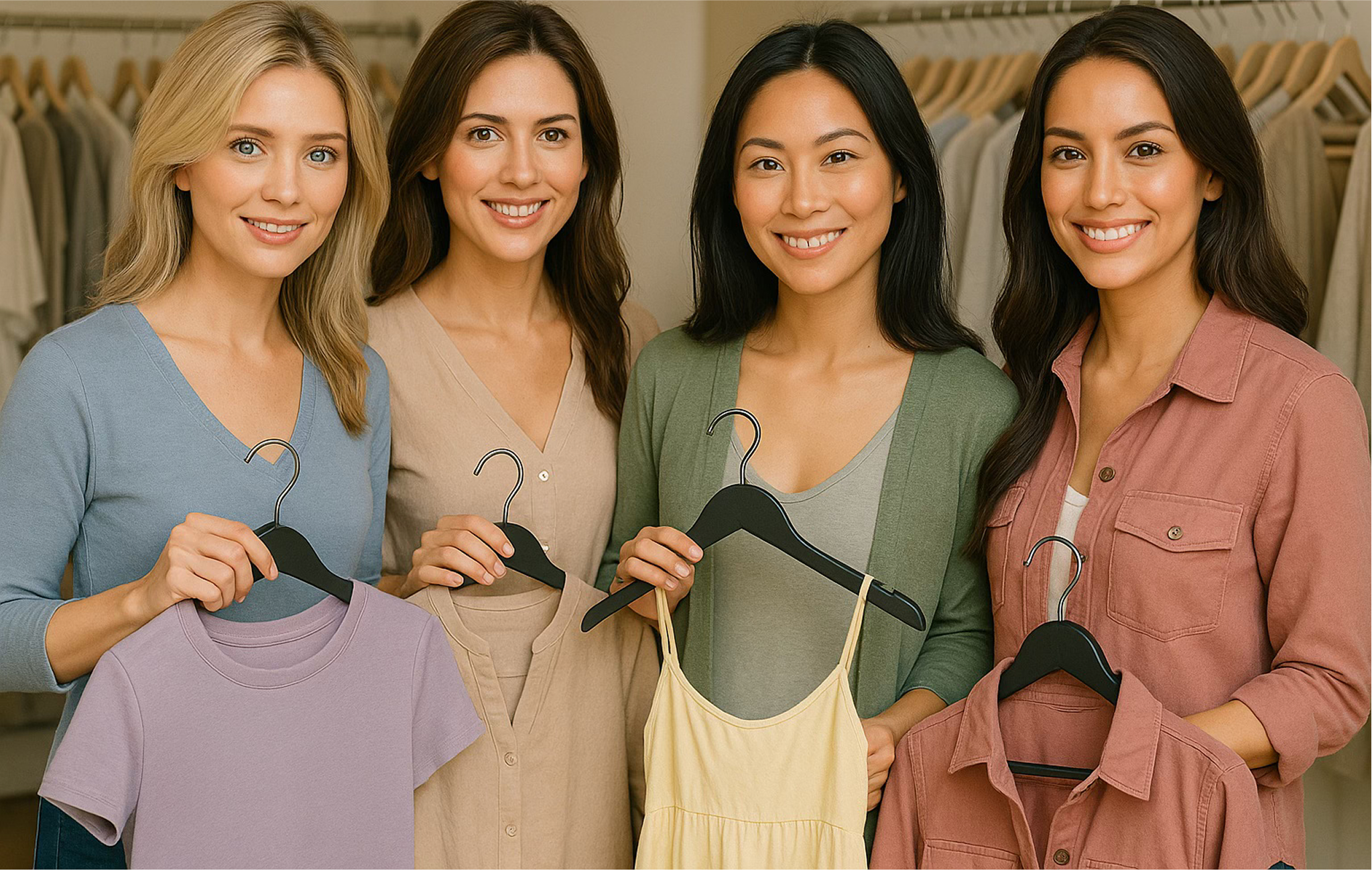The shirt remains one of the most fundamental garments in both men’s and women’s wardrobes. From precise tailoring to fabric composition, shirt design spans a wide range of styles, purposes, and quality standards. In this guide, we explore the technical distinctions between luxury and high street shirts, backed by factual comparisons in material science, garment construction, production scale, and fit consistency—plus recommendations across both categories.
At tellar.co.uk, our sizing tool uses body measurements and a proprietary fit algorithm to match your size across 1,500+ brands, bridging the inconsistencies between labels like COS, Massimo Dutti, Saint Laurent, and Uniqlo. This guide includes direct size links
and shirt-specific fit tips.Common Shirt Styles: Definitions and Functional Differences
Understanding shirt architecture is essential before assessing brand value. Below are the most prevalent shirt styles by structural and functional criteria:
1. Classic Button-Up
Construction: Full-length placket, stand collar, sleeve placket, and cuff.
Fabrics: Generally made from woven poplin, broadcloth, or oxford cloth.
Best For: Businesswear, formal occasions, or layered under suiting.
2. Oversized Shirt
Construction: Extended shoulder seams, dropped sleeves, boxy torso.
Fit Note: Requires proportional adjustment across chest and armhole.
Best For: Layering, streetwear, or relaxed tailoring.
3. Silk Shirt
Fabric Type: Charmeuse, habotai or sandwashed silk; generally 14–22 momme weight.
Best For: Eveningwear, luxury loungewear, or elevated daywear.
4. Utility Shirt
Features: Patch pockets, box pleats, reinforced seams.
Best For: Casual wear, particularly transitional seasons (cotton twill or brushed cotton).
5. Western Shirt
Signature Details: Yoke detail on shoulders, pearl snap buttons.
Fabrics: Usually denim, brushed cotton or chambray.
Best For: Casual and festival wear.
For an in-depth fit guide by shirt type, visit:
🔗 How Shirt Materials Affect Fit
Luxury Shirts: Technical Attributes and Brand Standards
Luxury shirts are not simply more expensive; they often justify the cost through superior textile quality, tailored cuts, and longevity of construction.
1. Fabric Quality
Cotton: Sourced from long-staple Egyptian or Sea Island cotton, increasing softness and pilling resistance.
Silk: Graded by momme (19–22 momme being premium), hand-finished, and often enzyme-washed for texture.
Linen: Belgian or Italian-spun, pre-washed to prevent excess shrinkage and provide drape.
2. Construction Methods
Seaming: Flat-felled seams or French seams reduce internal abrasion and increase durability.
Button Stitching: Often hand-sewn with reinforced cross-stitch and shank spacing for longevity.
Fit Engineering: Pattern-cutting software or bespoke hand-drafting is used to ensure anatomical shoulder slope and sleeve pitch alignment.
3. Design Philosophy
Designer shirts frequently feature:
Precision darts for waist shaping
Continuous plackets
Bias-cut panels for mobility or shape retention
Hidden button placements or hand-rolled hems
4. Sustainability and Ethics
Luxury brands like BITE Studios, Totême, and Stella McCartney publish traceability reports, use certified organic or circular fibres, and partner with low-volume, artisanal workshops.
Luxury Brand Recommendations – 2025
Brand | Key Features | Ideal For |
|---|---|---|
The Row | High-twist Italian cotton, invisible seams | Minimalist dress shirts |
Saint Laurent | Silk crepe, ultra-slim fit, exaggerated cuffs | Evening wear |
Totême | Boxy cotton styles, branded buttons | Capsule wardrobes |
Dries Van Noten | Pattern-cut motifs, unconventional dyeing | Statement pieces |
Raey (Matches) | Sandwashed silk, oversized cuts | Androgynous layering |
High Street Shirts: Strengths and Limitations
While high street shirts lack bespoke craftsmanship, modern innovations in textile blending and mass production have improved consistency and quality.
1. Materials
Cotton Mixes: Often blended with polyester (up to 40%) for wrinkle resistance and shape retention.
Sustainable Alternatives: Brands like Arket and M&S offer GOTS-certified organic cotton, lyocell (TENCEL), or BCI (Better Cotton Initiative) products.
Finishes: Mercerised or sanforised cotton is common, increasing sheen and reducing post-wash shrinkage.
2. Construction Shortcuts
Most high street shirts use lock-stitching, machine-set buttons, and fused collars, reducing cost but also garment lifespan.
Mass-produced sizing (e.g. S/M/L) leads to less anatomical accuracy across bust, shoulder, and waist measurements.
3. Design and Fit
Emphasis on trend replication: voluminous sleeves, cropped cuts, or printed collars.
Shorter production cycles mean frequent design refreshes but less R&D on fit engineering.
Top High Street Shirt Brands (UK)
Brand | Known For | Best Shirt Types |
|---|---|---|
COS | High-density cotton, structured cuts | Officewear classics |
Arket | Organic fabrics, tonal minimalism | Everyday basics |
& Other Stories | Embellishments, flared sleeves | Trend-led designs |
Uniqlo | Supima cotton, wrinkle-free tech | Everyday essentials |
M&S | Inclusive sizing, 2-way stretch | Workwear staples |
Zara | Fashion-forward design | Occasion or trend shirts |
For side-by-side size recommendations across these brands, use:
Luxury vs High Street: Technical Sizing Differences

Category | Luxury | High Street |
|---|---|---|
Size Labels | EU (36–42), FR (38–44) | UK standard (8–18) |
Sizing Variance | High (based on fashion cuts) | Moderate (S/M/L structure) |
Shrinkage | Minimal (pre-treated) | Moderate (cotton blends) |
Garment Longevity | 7–15 years (with care) | 2–5 years (typical wear) |
Pattern Accuracy | Tailored with darts or pleats | Straight block cuts |
For international size conversions and automated fit suggestions, try:
How to Evaluate Shirt Quality in Store or Online
Check GSM (grams per square metre): Cotton shirts with GSM >130 tend to last longer and drape better.
Button Material: Mother-of-pearl buttons are typical in premium shirts; plastic is common in high street.
Stitch Count: A high-end shirt will have 14–22 stitches per inch (SPI), while fast fashion may have <10 SPI.
Collar Stiffening: Removable collar stays and fused interlinings offer a longer-lasting collar shape.
Back Yoke: A split yoke (fabric cut on the bias) improves shoulder fit, rarely found in mass market shirts.
Care Considerations: Fabric Longevity
Fabric | Wash Temperature | Ironing | Notes |
|---|---|---|---|
Cotton Poplin | 30–40°C | High heat | Iron inside-out |
Silk | Cold hand wash / dry clean | Low heat | Avoid water spots |
Linen | 30°C, gentle | Medium heat | Tumble drying discouraged |
Polyester Blends | 40°C | Medium | Retains shape but pills over time |
Final Considerations: Which Should You Choose?
For Daily Wear: Opt for Arket or Uniqlo with durable cotton blends and easy care.
For Investment Pieces: A silk shirt from The Row or tailored cotton from Totême offers longevity, elevated design, and better fit.
For Fit-Sensitive Buyers: Use Tellar.co.uk’s size-matching tool to ensure correct fit regardless of brand.
✅ Start with Your Measurements – It’s Free & Easy
At tellar.co.uk, we help you:
Match your measurements to the correct size in 1,500+ brands
See fit differences between luxury and high street
Convert sizes across UK, EU, FR, US standards
Get real-time sizing on web or app (coming soon)
👉 Create your size profile now
👉 Or try the Store Size Lookup Tool
Connect With Us for More Sizing Insights:
Let Tellar.co.uk simplify your shirt shopping—wherever you choose to buy. Whether it’s silk from Saint Laurent or poplin from COS, fit comes first—and we help you get it right, every time.
